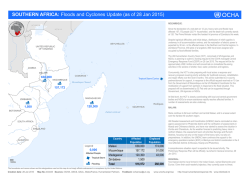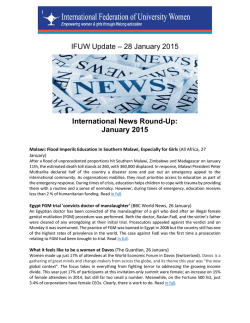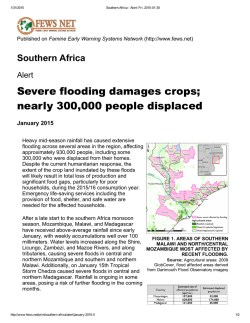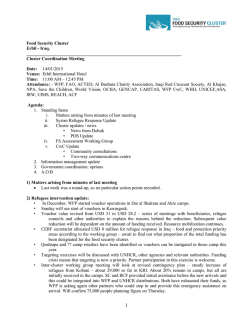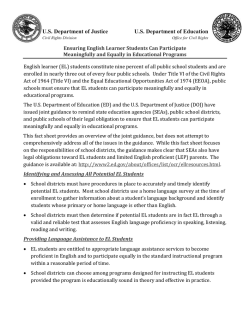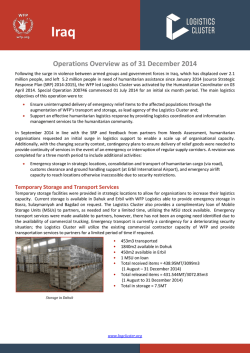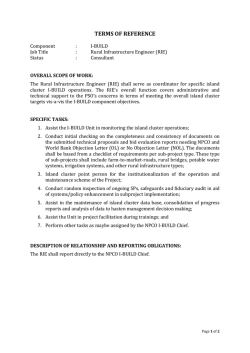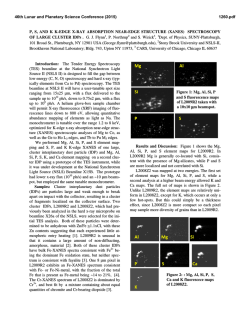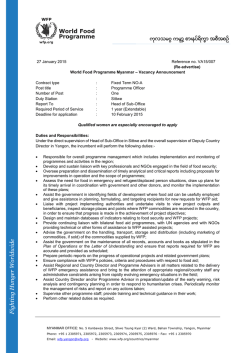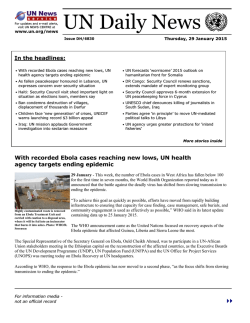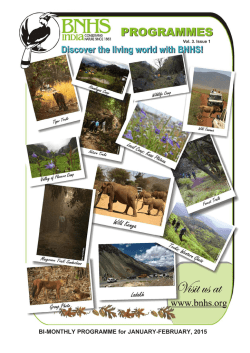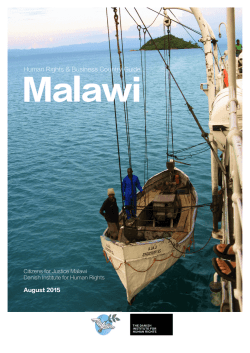
Malawi_Floods-DoDMA-UNRCO_Situation_Report-n_5
Malawi: Floods Department of Disaster Management Affairs (DoDMA) United Nations Office of the Resident Coordinator Situation Report No. 5 (as of 30 January 2015) This report is produced jointly by the Department of Disaster Management Affairs (DoDMA) of Malawi and the United Nations Office of the Resident Coordinator in Malawi, in collaboration with humanitarian partners. It covers the period from 28 to 30 January 2015. The next report will be issued on or around 03 February 2015. Highlights Weather outlook for the period 30 January to 05 February 2015 forecasts continued above normal rains. High rainfall amounts continue to be recorded particularly along the Shire River Basin, posing risks of further flooding in already flood affected districts. More funding is required to scale up the response in all sectors. Despite ongoing interventions, the outstanding gaps leave the displaced population highly vulnerable and at risk. A briefing to Member States was held in Geneva on 29 January as part of the comprehensive resource mobilization strategy of the Government of Malawi and the Humanitarian Country Team. A joint CERF Rapid Response application was submitted 30 January 2015 focusing on meet immediate needs and life-saving activities in the three worst hit districts. UNDAC is expected to complete assessment of all 15 affected districts by 30 January 2015. 638,000 15 174,000 79 153 63,976 Estimated affected people countrywide Affected districts Displaced people in the 3 most affected districts Deaths Missing people in Nsanje District Hectares of land flooded Situation Overview According to the Malawi Meteorological Services, widespread rains associated with local heavy downpours are expected to continue affecting the country during 30 January to 05 February. Cumulatively, high rainfall amounts are still being recorded especially in Shire River Basin and this will exacerbate the flood situations in the districts of Nsanje and Chikwawa. The risk of flooding is also still high in Phalombe, Mangochi, Salima, Nkhata Bay and Karonga. With response efforts stretched to meet current humanitarian needs, the risk of further flooding raises a critical concern. Preparedness and response efforts should therefore be scaled up in all sectors. Provision of shelter and NFIs is inadequate in most sites. More suitable temporary shelter sites are immediately required in some areas. The congestion and lack of hygiene are incrementing the risk of water borne and other diseases in the sites, including malaria and diarrhea. Continued relief food assistance including targeted supplementary feeding (for children under 5, pregnant and lactating women) is a key priority given the rise in malnutrition cases. Protection issues are also a concern, with some cases of sexual abuse and transactional sex reported in some displacement sites. Department of Disaster Management Affairs of Malawi United Nations Office of the Resident Coordinator Malawi Floods - Situation Report No. 05 |2 UPDATES FROM THE DISTRICTS Nsanje The commencement of the WFP relief food distribution as of 30 January is expected to address the critical food gap that has been reported from the district resulting in a reduction of meals. Shelter pipelines are building up with new actors planning to bring in shipments of plastic sheeting, tents as well as NFIs. The requirement, however, outpaces the intervention to date. Reports from GOAL and MSF who have been active in east bank (Mobile clinic, NFI delivery, HEB distribution) indicate that some schools that used to accommodate IDPs have re-opened resulting in dispersed settlement of the IDPs in up to 6 or 7 satellite locations. Other sites that were previously referred to as one site were verified to be combination of satellite camps. Some are entirely surrounded by water and have so far only been reached by limited food assistance. Ongoing registration for distribution of monthly rations is slow due to logistical constraints and the large amounts of households to be registered. On 30 January 2015, MSF carried out malaria tests for under 5 years in James Mchacha displacement site (2,127 HH), with between 40 to 50 percent positive. Displacement areas assessed by UNDAC/MSF/GOAL/Red Cross in the last 3 days identify exact locations and numbers of displacement sites and areas in the east bank (TA Mlolo) and also identified outstanding needs. Some actors have already committed to partially cover the gaps. Relocation of displaced people from Bangula School to Admarc camp started on 28 January. As IDPs are relocated from schools into alternative sites, access to water is a major challenge as new sites do not have boreholes. Water is not treated in the majority of sites due lack of chlorine or water guard. Alternative water trucking systems are being studied with water treatment plants in water collection points. Verification of cases of unaccompanied minors (618 child headed households) is underway to trigger appropriate response including family tracing. There are serious protection concerns given that the displacement sites have no well-lit latrines. Regular coordination meetings have been established, under the leadership of the District Commissioner. However, some logistics issues (power, internet, stationery and fuel) are challenging the DC Office and the EOC operations. Chikwawa The ongoing humanitarian assistance remains insufficient to cover the enormous sector requirements in the camp sites. Outstanding critical gaps include provision of suitable shelter, lighting in camp; mosquito nets; firewood and shortage of medical personnel (Malawi Red Cross and MSF are working in the area). Humanitarian needs remain estimates and a validation exercise is underway through local partners World Vision and Malawi Red Cross as well as the district appointed site coordinators. Many people are still sleeping in the open as there is a lack of appropriate shelters. As of 29 January, only 150 family tents had been distributed. More qualified and quantified information is being provided by site coordinators to be inputted for strategic overview planning for the 19 sites in the district. Six site specific reports have been received so far. Cluster partners recommend the establishment of temporary shelter, built of local material and plastic sheeting and tarpaulins, which can be reused when they are able to return to their villages to ensure access to suitable shelter. Meanwhile, the cluster is planning for the arrival of 1,000 shelter kits from Shelter Box next week. A small proportion of the IDPs are reported to have returned to their villages to initiate rehabilitation/reconstruction of houses. There is an urgent need to establish a sustainable registration system of people in need of humanitarian assistance despite leaving the sites. Mosquito net distribution remains minimal despite the critical need. Several boreholes are reported to have problems as their capacity has been overstretched. Water mission is working with Government to fix problems as they are reporting but they do not have capacity to establish new boreholes. Tension between villagers and IDPs on the use of boreholes have been reported. Another 130 latrines were built but numbers are still inadequate in all sites. If sanitary conditions are not improved quickly there is a high risk of disease outbreaks in many of the camps. All sites have now been reached with some kind of food distribution but with uneven coverage. Malnutrition has been reported in several camps and targeted feeding needs to be undertaken. Department of Disaster Management Affairs of Malawi United Nations Office of the Resident Coordinator Malawi Floods - Situation Report No. 05 |3 The results of the verification done by the Malawi Red Cross of the east bank are expected to be shared soon. Ongoing multi-sector interventions are tracked on a daily basis with the 3Ws template to support a more accurate gap analysis and avoid duplication of efforts. The EOC has requested the clusters in validating and quantifying the gaps. Coordination meetings will be held every second day starting from 28 January. Absence of sector/cluster coordination mechanisms at district level and the fact that no agencies have been designated as lead coordinator for different sector continues to be a challenge. The number of actors coming to the EOC has increased and briefings of the situation are held on daily basis. Phalombe The DC with the support from EOC held cluster meetings on 29 January (health, protection and education). UNICEF will support in leading the WASH and Education clusters. Health sector interventions were identified to be top priority in the camps; there is a need to undertake health assessment in the district considering the potential risk of water borne diseases outbreaks. All food distribution has been completed including pre-positioning of stocks in Chiwalo and a response tracking matrix developed. There is however a need to guide the clusters in completing key information that will help in the decision making process as well as mobilization and prioritization of assistance including gap analysis. Funding Following the Declaration of a State of Disaster by the President of Malawi on 13 January 2015, the humanitarian community supported the GoM to develop a response plan. On 21st January 2015, the GoM, in collaboration with the HCT, announced the launch of the Preliminary Response Plan (PRP), built on inputs from the GoM led and partner co-led clusters, for a total of US$ 81 million. Up to 30 January 2015, the PRP has been funded at 21%, with big gaps in critical humanitarian sectors, which needs confirmed financial support in this first stage of the emergency response. HCT enhanced their resource mobilization strategy, which succeeded in a reallocation of funds for the current floods emergency. At international level, a UN Member States briefing took place on Thursday 29 January 2015 in Geneva, with the participation of the Minister of Lands and Housing and Chairman of the National Disaster Preparedness and Relief Committee in Malawi, the UNRC and a representation of the UNCT (WFP, FAO and UNICEF), and discussions are underway to have similar briefings during the first week of February 2015 in New York and South Africa. The mobilization of resource is still ongoing with pledges and donations in-kind and cash coming from number of international cooperation agencies and foreign governments including Zambia, Japan, South Africa, Canada, Germany, Norway, Iceland, United Kingdom and others. Botswana has made donations in kind to the Government of Malawi and is expected to arrive on 30 January. In-country private sector donated in-kind contributions. China Enterprises and Lilongwe Overseas Chinese Chamber of Commerce have donated NFIs equivalent to MK10 million (US$ 21,700). Some of these pledges will be managed through the One UN Fund (Humanitarian Window), which already mobilized US$ 446,000. The World Bank, the African Development Bank and ECHO have also made pledges and contribution for the emergency response and recovery activities. However, actual contributions are needed to avoid an aggravation of the critical situation of the most affected people. In addition, a funding request has been sent on 30 January 2015 to the Rapid Response Window of the Central Emergency Response Fund (CERF) to address the immediate needs of the hardest hit districts: Phalombe, Nsanje and Chikwawa. The application focuses on six prioritized sectors identified by the Government of Malawi and the Humanitarian Country Team. The areas are: 1) shelter and camp management, considering protection issues; 2) food security; 3) agriculture; 4) transport and logistics; 5) education and 6) water, sanitation and hygiene. All humanitarian partners, including donors and recipient agencies, are encouraged to inform DoDMA and the OCHA's Financial Tracking Service (FTS http://fts.unocha.org) of cash and in-kind contributions by e-mailing: [email protected] Department of Disaster Management Affairs of Malawi United Nations Office of the Resident Coordinator Malawi Floods - Situation Report No. 05 |4 Humanitarian Response Shelter & Camp Management Cluster Lead: Ministry of Lands and Housing Co-Lead: Malawi Red Cross Needs: Provision of shelter and camp management assistance remains a priority Chikwawa, Nsanje and Phalombe Shelter is required in overcrowded collective centres and in schools sites that need to re-open. 3,567 Tents required in worst affected districts Response: According to the Ministry of Land, Housing and Urban development, a total of 243 tents have been distributed to the districts of Chikwawa (149), Zomba (6), Nsanje (21), Phalombe (64), Mulanje (3). A total of 100 tarpaulins and 100 plastic rolls have been distributed in the district of Machinga. Site coordinators have been requested to establish a short and medium term plan for each site. In Nsanje, site developments are ongoing with provision of tents and WASH facilities by partners (Red Cross, ACT, UNICEF, UNHCR, Goal, PDD). The cluster has scaled up, with a team leader and information manager in Lilongwe, and an advisor in Blantyre. The shelter cluster is collecting 4W information from implementing partners to quantify gaps. Gaps & Constraints: According to the Ministry of Land, Housing and Urban Development, another 232 tents are needed in Chikwawa (35), Balaka (15), Zomba (65), Nsanje (117). A total of 2700 households need to be relocated from camps, as they are overcrowded: Chabuka, 314 HH, Livinzu, 140 HH, Bodza, 123 HH, Malemia, 1221 HH, Tizola Grain Bank, 554 HH, Tizola Cikuse, 317 HH, and Medrum, 51 HH. Despite ongoing provision of shelter and NFI by several actors, critical gaps are reported in all displacement sites. There is a need for more camp management actors to support camp site identification and management. Lack of clarity of the number and status of the camps and the exact number of the displaced remains to be a critical gap. Food Security Cluster Lead: DoDMA Co-Lead: WFP Needs: Food assistance is anticipated to be required up to end of July 2015. Using initial estimates, the total estimated requirement is 26,000 MT at an estimated cost of US$ 17.9 million, with the associated logistics costs. 26,000 MT required for food assistance Response: As of 30 January 2015, WFP has dispatched 1,192 MT to reach approximately 33,698 households (185,339 people) in Chikwawa, Mulanje, Zomba, Ntcheu, Phalombe, Nsanje and Machinga flood affected districts. The distribution of the relief food ration is progressing in Nsanje, which is expected to address the critical gaps that resulted in reduction in meal intake in most camps. Relief Food Distribution Plans have also been received from implementing partners from Karonga, Mangochi, Salima, and Balaka districts and dispatch of relief food is to commence on 30 January 2015. Several actors have also been providing relief food items (different quantities and types) coordinated through the DC consisting mainly maize flour and soya beans. WFP has received pledges amounting to US$ 7.1 million, but to date no contributions have been confirmed. Gaps & Constraints: Associated costs are urgently needed to draw-down, transport and distribute the government in-kind contribution of 14,000 MT of maize from its Strategic Grain Reserve (SGR). WFP urgently requires US$ 17.9 million to continue its food assistance to the flood-affected population. An immediate response to the sudden onset of the floods disaster was enabled by moving food stocks already in the country which need to be replenished. Although some pledges have been made by different donors, the incountry food stocks are running low. Unless new contributions are confirmed immediately, food assistance to the flood-affected population will halt in 15-20 days. Department of Disaster Management Affairs of Malawi United Nations Office of the Resident Coordinator Malawi Floods - Situation Report No. 05 Verification of actual beneficiary figures for the distribution plans reportedly delayed relief food distribution in some affected districts. The Food Security Cluster decided to for partners to immediately commence distribution with the planning figure, while undertaking verification assessments to identify the additional requirements. Though there are improvements in accessing displacement sites in areas cut off by flood waters with ongoing airlifting operation, challenges in terms of ensuring timely adequate response to all affected sites remain. Outstanding challenges in ensuring that all displaced households are provided with assistance given that food distributions are partly undertaken at distributions points, not per site. Some flood-affected areas remain cut off from markets and other food supplies. Damages to crop fields are expected to have long-term consequences for the affected population’s food security Agriculture Cluster Lead: Ministry of Agriculture Co-Lead: FAO Needs: |5 116,000 According to the Government, 116,000 households lost crops and livestock (or part of), affecting a total of 68,000 hectares. Farmers affected A survey undertaken by Ministry of Agriculture, Irrigation and Water Development (MoAIWD) indicated that 42,000ha of agriculture land has been destroyed and over 100,000MT of yield is estimated to be lost. Response: Provision of assistance to undertake replantation of sweet potato vines and cassava is planned to commence in the coming two weeks. Concern Universal is procuring sweet potato vines and early maturing maize seed for 5,773 households affected by floods, with funding from Irish Aid. Gaps & Constraints: As of 26 January 2014, the funding contribution constituted only 10 per cent of the requirement. Given that the planting window for maize closed during the third week of January 2015, farmers have to opt to planting other crops such as cassava. Transport & Logistics Cluster Lead: Ministry of Transport and Public Infrastructure Needs: Road access to Chiwalo in Phalombe and east bank in Nsanje and Chikwawa has been hampered due to flooding. US$ 8.4 million Response: Co-Lead: WFP still need to cover logistics requirements Through a Special Operation currently under preparation, WFP experts will provide logistics augmentation to cover access gaps for the humanitarian community, using an helicopter Mi80, special 4x4 fleet and boats, where necessary. The cluster logistics, co-lead by WFP, is also prepared to offer service provisions under full cost recovery for areas of the country that are accessible. 1 MDF helicopter Puma; 2 South Africa helicopters Hueys are also undertaking airlifting operations in the inaccessible areas, in coordination with the logistics cluster. The Logistics Cluster and MDF have made available road transport capacity to dispatch relief items in the accessible areas. Gaps & Constraints: The flooding has damaged a significant number of roads and bridges, which makes a priority the support to logistics operations. Repairing damaged road access stands to be of top priority to ensure continued supply of relief items to inaccessible affected areas. Education Cluster Lead: Ministry of Education, Science and Technology Needs: There is a need for 800 tents to house temporary classrooms. School-in-a-box kits are needed to resume learning as soon as possible in temporary classrooms. Department of Disaster Management Affairs of Malawi United Nations Office of the Resident Coordinator Co-Lead: UNICEF 300,000 Learned affected Malawi Floods - Situation Report No. 05 |6 School feeding and kitchen kits are needed to support resumption of education activities. Psycho-social support is needed, including play and recreation facilities. Response: Total number of cumulative beneficiaries of the cluster response, including WFP School feeding, is now 96,000. Installation of 50 school tents and distribution of 563 school-in-a carton kits by World Vision is ongoing in 7 districts. Mobilization for psychosocial support to deploy teachers into the field is ongoing by Development Aid from People to People (DAPP) and World Vision. Gaps & Constraints: Two verification teams deployed in the field reported potential hazard for children related to escalation of poor hygiene due to open defecation in the displacement sites. Although relocation of displacement sites from schools has commenced, many schools in the flood-affected areas are still being used as displacement sites, which has a high impact in the regular education activities. Health & HIV Cluster Lead: Ministry of Health Needs: Co-Lead: WHO US$ 3.8 million Prevention and control of disease outbreaks such as cholera, dysentery, still need to cover health malaria, malnutrition. requirements Provision of treatment of acute and chronic diseases and injuries. Establishment of temporary consultation, treatment and maternity delivery shelters within the displacement sites. Strengthen early detection and reporting of disease outbreaks. Sustain immunization and growth monitoring of children under age 5. There is a significant risk of disease outbreaks such as cholera and malaria. For instance, in Nsanje, MSF carried out malaria tests on 28 January for children under age 5 and slightly older children with 80 per cent turning positive. Response: The health team has identified 5 camp sites to open mobile clinics to provide integrated maternal and child health services in flood affected locations of Nsanje and Chikwawa in collaboration with District Health Officers (DHO) and UNICEF. UNICEF assisted in deployment of 3 Health Surveillance Assistants (HSAs) to run village clinics in 3 camps in Chikwawa and distributed antibiotics, Oral Rehydration Salts (ORS) and zinc at health post and village clinics for displaced population in affected facilities and camps. To date, YONECO has reached 11 camps in Nsanje and Chikwawa with counselling and edutainment for approximately 1,249 children and adolescents, particularly on HIV prevention and sexual and reproductive health, and provided referrals to nearby health facilities. Gaps & Constraints: There is a critical gap in malaria prevention and response including provision of mosquito in most sites, despite the high number of cases and prevalence of risk factors raising serious concerns. As mosquito nets are hard to use in tents, there is need for spraying and other measures in addition to nets given sites conditions. There are increasing reports of diarrheal cases. Poor sanitation in the camps including reports of open defecation pose serious health threats such as cholera. Crowded conditions and reports of transactional sex among adolescent girls are of growing concern, given the risk of sexual transmission of HIV. Protection Cluster Lead: Ministry of Gender, Children and Social Welfare Needs: Psychosocial support including counselling. Security and protection of displaced people including through the provision of lighting and security. Referral and linkages to families and other services such as reproductive health, counseling and rehabilitation. Provision of assistive devices to persons with disabilities Department of Disaster Management Affairs of Malawi United Nations Office of the Resident Coordinator Co-Lead: UNICEF 108 Unaccompanied children in Zomba and Nsanje districts Malawi Floods - Situation Report No. 05 |7 Response: The Ministry has deployed 18 social workers to all 15 affected districts to provide protection support. In Chikwawa, Youth Net and Counselling (YONECA) is providing counselling for youths. Emmanuel International is working in 3 sites in Machinga. UN Women has enhanced the support to partners and clusters with a Gender officer, aiming at improving the mainstreaming of gender issues in humanitarian planning and response activities. UNFPA hired a national GBV coordinator to improve planning and response in this sub-cluster. Gaps & Constraints: The case of unaccompanied children in the camps separated from their family is of critical concern. Tracing of families has proved difficult due to inaccessibility of some camps; There are reports of increased vulnerability of women and girls to GBVs with cases of transactional sex. All children that have been separated from their families need to be identified, facilitating family tracing. Care should be provided for unaccompanied and separated children. A number of challenges exist at the displacement sites including no separation of men and women in some sites and many sites have inadequate lighting. Water & Sanitation Cluster Lead: Ministry of Water Development and Irrigation Needs: Provide basic water, sanitation and hygiene supplies and equipment, which include chlorine/water purification tablets, plastic sheeting, and soap water testing kits (to the estimated 14,000 households/ 70,000 people), including kits for immediate repair of water installations (piped water supply systems, hand pumps and springs) at institutional and community level. Co-Lead: UNICEF US$ 1.8 million still need to meet WASH requirements Response: A total of 120 latrines were constructed by GOAL Malawi as of 28 January addressing 22,283 displaced people. A total of 500 latrines are planned to be constructed across the camps in Nsanje and Chikwawa. Furthermore, GOAL Malawi undertook 62 hygiene awareness raising sessions across 7 camps focusing on hand washing. Goal has also installed 27 hand washing facilities and distributed over 12,000 bars of soap. Water Missions International has set up a water treatment system for three camps in Chikwawa District targeting 8,981 people. Through agreements with Catholic Relief Services and Concern Universal, installation of safe drinking water supply and sanitation facilities in 28 camps in Phalombe and Zomba Districts targeting 10,000 camp residents. Population Services International has commenced hygiene promotion intervention in 40 camps in Phalombe, Chikwawa and Nsanje Districts. A water bowser has been deployed to provide safe drinking water to a total of four camps in Nsanje targeting over 12,000 people. Chlorine for water treatment has been provided to a large number of health centres across the districts in order to ensure access to clean water Gaps & Constraints: The sanitation facilities within the current sites are inadequate to accommodate the number of displaced people. Number of persons per latrines exceeds recommended numbers. There are reports of open defecation around the camps sites posing health threats; Access to clean water remains generally inadequate; Nutrition Cluster Lead: Department of Nutrition Needs: Nutritional and therapeutic supplements for children at risk of malnutrition Feeding of young children, expectant and lactating mothers, the elderly, people with disabilities, orphans and the chronically ill. Department of Disaster Management Affairs of Malawi United Nations Office of the Resident Coordinator Co-Lead: UNICEF US$ 1.2 million Still needed to the emergency nutrition response Malawi Floods - Situation Report No. 05 |8 Response: Nutrition screening is undergoing in Nsanje and Chikwawa camps in collaboration with Health Surveillance Assistants (HSAs), UNICEF and NGOs targeting children under 5, pregnant and lactating women to trigger appropriate response; A total of 196 severely acute malnourished under-five children have so far been admitted in Nutrition Rehabilitation Unit (NRU) and Out Patient Therapeutic Programme (OTP) as of 28 January. Gaps & Constraints: Inadequate food supply for under five children is resulting increasing number of moderately and acutely malnourished children in the camps. General Coordination The Government of Malawi is leading the response, through the Department of Disaster Management Affairs (DoDMA), with support from humanitarian partners, including NGOs, the UN System and donors. The cluster system has been activated, and inter-cluster meetings have been happening twice a week to ensure proper operational cross-sector coordination. The Office of the Vice President, through DoDMA, is convening meetings of the National Disaster Preparedness and Relief Committee twice a week to share progress report on the floods response. The Government has established Emergency Operations Centers in Lilongwe, Blantyre, Chikwawa, Nsanje and Phalombe with the support of the UNDAC Team in coordinating the response. In addition to the EOCs, Government has opened a toll-free hotline 115 on which people may call to report issues related to disasters. The Malawi Defense Force (MDF) and Malawi Police Service (MPS) have seconded senior officers to the National Emergency Operations Centre to support DoDMA in the coordination and operations of the response. These structures are not intended to bypass already existing local structures, with District Commissioners continuing to be responsible at the district level. The MDF and MPS are also providing operational and logistical support at district level in order to improve coordination of the response. Government is also ramping up preparedness efforts in the North of the country where more rains are expected. In addition, the humanitarian community is supporting the Government in terms of coordination and response. The IFRC sent a Field Assessment Coordination Team (FACT) to Malawi for a period of 3 months to support the Malawi Red Cross in the response. The Humanitarian Country Team is supported through the cluster system sectoral relief operations. Some agencies have already deployed specialized experts to the field. The OCHA Regional Office for Southern Africa has deployed a surge team, which is working is close collaboration with the UN Resident Coordinator’s Office, the HCT’s members and DoDMA. Also, the UN Disaster Assessment and Coordination (UNDAC) Team, deployed on 16 January 2015, continue to conduct rapid assessment and supporting the coordination at local level (districts), regional (Blantyre) and national (Lilongwe). Background on the crisis Heavy rains over the last few weeks have led to severe flooding across Malawi. The floods have also caused extensive damage to crops, livestock and infrastructure. The Southern districts of Nsanje, Chikwawa and Phalombe are the most affected. A growing concern is disease outbreak, given the poor sanitary and drainage conditions at relocation sites. In response, the President of the Republic of Malawi declared a State of Disaster in the 15 affected districts (out of a total of 28 districts) on 13 January 2015. With the numbers of people affected and displaced continuing to rise, the President has appealed to the international community for support, specifically in the provision of tents, food and non-food items; and in the conducting of search and rescue operations. Some areas are inaccessible, impeding the conducting of assessments. While a decrease in rainfall is forecast for Southern Malawi, more rains are predicted for the North of the country. Malawi has been receiving significant rains since December 2014, and this trend is expected to continue as the country is forecast to receive normal to above-normal rainfall between January and March 2015. For further information, please contact: Mr. James Chiusiwa Ms. Mia Seppo Director of DoDMA UN Resident Coordinator in Malawi [email protected] [email protected] More information on: http://www.humanitarianresponse.info/operations/malawi Department of Disaster Management Affairs of Malawi United Nations Office of the Resident Coordinator
© Copyright 2024
